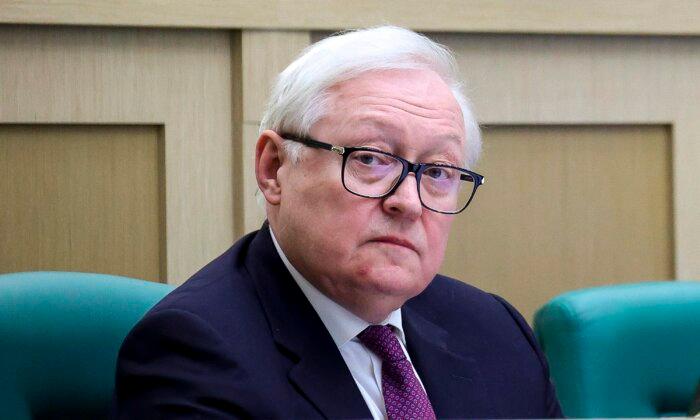After this week’s landmark phone conversation between U.S. President Donald Trump and Russian counterpart Vladimir Putin, speculation has mounted that the three-year-old war between Russia and Ukraine may soon draw to a close.
In advance of expected U.S.-backed peace talks, the warring sides are now scrambling to improve their positions, especially in the frontline city of Pokrovsk.
“If Ukraine keeps Pokrovsk, it strengthens their negotiating position,” Tim Ripley, a prominent British defense analyst, told The Epoch Times. “If they lose it, Russia gains more ground to trade.
“It’s a zero-sum game.”
Located in the eastern Donetsk region, Pokrovsk (Krasnoarmeysk in Russian) has long been regarded as strategically vital.
A key Ukrainian transit hub, it is often described in the Russian media as the “gateway to Donetsk.” It is home to a major railway station and sits at the junction of several supply routes linking it to other cities and towns in the region.
“Pokrovsk is extremely important for Ukraine in terms of military procurement in Donetsk,” Ferit Temur, a Turkish political analyst and expert on Russian affairs, told The Epoch Times.
“Along with the city of Izyum [roughly 90 miles to the north], Pokrovsk feeds northwestern Donetsk, which remains under the control of Ukraine’s Khortytsia operational-strategic group, to which it provides a supply line.”
In addition to cutting Ukrainian supply lines, the fall of Pokrovsk would allow Russian forces to advance westward—into the Dnipropetrovsk region—and northward toward the Donetsk cities of Kramatorsk and Sloviansk.
It would also bring Moscow one step closer to cementing control over the entire eastern Donbas region—a longstanding Russian objective.
“On the eve of negotiations with the Trump administration, the two hostile sides are seeking to consolidate their military gains on the ground, which will strengthen their hand at the negotiating table,” Temur said.
In 2022, Russia effectively annexed Donbas—which is comprised of Donetsk and Luhansk—along with two other regions of southern Ukraine, after holding public referendums.
Since then, Moscow has regarded all four regions as Russian Federation territory.

Battles Raging
Since 2023, when it consolidated its forces along a roughly 600-mile-long frontline, Russia has slowly but steadily advanced northward and westward across both Luhansk and Donetsk.According to Ripley, also the author of “Little Green Men: The Inside Story of Russia’s New Military Power,” Russian forces now control “almost all” of the former and “roughly three-quarters” of the latter.
In recent months, they have honed in on Pokrovsk, threatening the city with envelopment—a time-worn Russian military tactic referred to as a “cauldron.”
“It’s a Russian concept, how they fight these battles,” Ripley said. “They’ve used this maneuver on several occasions along this front and still seem to be employing the same method.
“Why attack head-on when you can achieve the same objective in a more effective and cost-efficient way?” he explained.
Days earlier, Russian forces reportedly reached the main rail line linking Pokrovsk to the Ukrainian city of Dnipro, which sits roughly 110 miles to the west.
Since then, Russia has claimed to have made several more significant gains, both to the east and south of Pokrovsk.
The most notable of these was on Feb. 7, when Russia’s defense ministry said that its forces had captured the town of Toretsk, roughly 30 miles east of Pokrovsk.
On Feb. 11, Moscow said that its forces had captured a village—Yasenove—some 13 miles south of Pokrovsk. Two days later, it announced the capture of another village—Vodyane Druhe—roughly 15 miles east of the city.
Kyiv has yet to confirm the reported territorial losses, which The Epoch Times could not independently verify.
Nevertheless, few informed observers dispute that Russian forces are steadily closing in on Pokrovsk.
“Over the past few weeks, the Russians have pushed into positions on the flanks of Pokrovsk to the southwest and northeast,” Ripley said. “They’ve cut the main road from the west and another that leads into the east of the city.
“This forces the Ukrainians onto a north-south supply route,” he added. “By cutting off the supply routes, the Ukrainians are left exposed, making them easier targets.
Ripley noted videos showing roads leading into Pokrovsk “littered with blown-up trucks and armored vehicles that were hit as they tried to move under artillery fire.”
Meanwhile, Ukrainian commanders deployed in Pokrovsk complain of relentless assaults by Russian infantry units, along with drone and artillery attacks.
“Day and night they are moving forwards.”
According to Ripley, Ukrainian forces have sought to slow the Russian advance with their own counteroffensive.
“But I’m not sure how successful this has been,” he said.
On Feb. 13, Igor Kimakovsky, a top DPR official, said Ukrainian forces had intensified efforts to stop Russian troops from overrunning the village of Shevchenko, which sits immediately south of Pokrovsk.

Geopolitical Circumstances
Because Russian forces have enveloped Pokrovsk, the city’s strategic value—at least for Ukraine—has been largely neutralized, according to Ripley.“Initially, its strategic value was due to its road and communication links,” he said. “But now that the roads and rail lines have been cut, it has lost that value.
“The city itself is largely abandoned,” he added. “It’s well within Russian artillery range, with attacks occurring daily, and most of the civilian population has left.”
According to local officials, only 7,000 residents remain in Pokrovsk out of a pre-war population of approximately 60,000.
“At this point, its value is mostly symbolic—similar to previous battles where a city is held more for the sake of holding it rather than for strategic advantage,” Ripley said.
“The question for Ukraine is whether they think they can inflict more Russian casualties by holding it or if they should retreat to a better defensive position.”
Asked if he viewed Pokrovsk’s capture as a foregone conclusion, Ripley said this would likely depend on “geopolitical circumstances.”
“If a peace negotiation were suddenly agreed upon, fighting might halt—but that seems unlikely,” he said.
Both sides, he added, “want to push as far as possible before sitting at the [negotiating] table because the more territory they hold, the stronger their bargaining position.”
The prospect of peace talks was vastly enhanced on Feb. 12, when Trump held a landmark phone conversation with Putin, which was followed by a call with Ukrainian President Volodymyr Zelenskyy.
The following day, U.S. Defense Secretary Pete Hegseth announced that Trump sought to bring the warring parties together with a view to achieving a “negotiated peace.”
Hegseth also said that it was “unrealistic,” given facts on the ground, to expect that Ukraine might return to its pre-war borders as part of a settlement.
The prospect of looming U.S.-led peace talks has both sides scrambling to maximize their positions—both in Donetsk and Russia’s western Kursk region.
In August last year, Kyiv launched a surprise cross-border offensive into Kursk, which shares a border with northeastern Ukraine.
Ukrainian troops initially captured several hundred square miles of Russian territory, more than half of which has since been retaken by Russian forces.
Nevertheless, despite fierce counterattacks, Ukrainian forces have continued to hold a small but significant swath of Russian territory near the border.
According to Ripley, Kyiv’s efforts to hold territory in Kursk have served to divert Ukrainian forces from the Donetsk front, including Pokrovsk.
“The geopolitical need to maintain control of Russian territory as a bargaining chip is keeping Ukrainian forces stretched,” he said, adding that Ukraine’s “only real bargaining chip” was the sliver of territory it still holds in Kursk.
“They haven’t been able to push the Russians back anywhere else. In fact, they’ve lost ground.”
Now, according to Ripley, the key question for Ukraine is: “What price can they extract from Russia in exchange for Kursk?”
Ripley noted that Russian forces also hold a small part of Ukraine’s northeastern Kharkiv region, which “wasn’t part of their original annexation plan.”
“This could be another bargaining chip in negotiations, which might be traded for parts of Kursk,” he said.
Given the prospect of imminent peace talks, “Every piece of captured land matters.”







